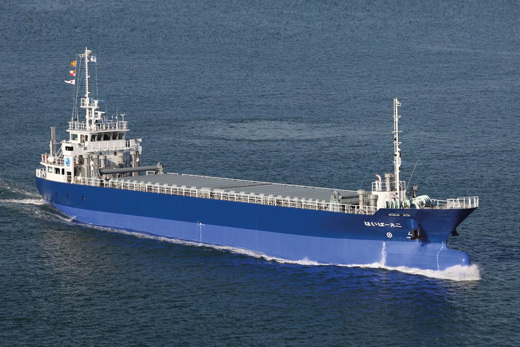
In the past bulk carriers have utilized diesel-mechanical propulsion. However, with developments in electric propulsion technology this now offers many advantages, such as high redundancy, flexibility in equipment layout, energy savings and reduced exhaust gas emissions. After long-term studies, Japanese ship-owner Mukaishima Dock Co., Ltd. decided to build a bulk carrier with electric propulsion, mainly for steel transportation on the Inland Sea of Japan. This vessel ushers in a new era of electric propulsion for bulk carriers.
The electric propulsion system on Mukaishima Dock’s bulk carrier was integrated by the 712 Research Institute in Wuhan, China. With its high-level technical skills and knowhow, the 712 Research Institute overcame competition from many companies with global reputations as well as local companies in Japan and was selected as electric propulsion system supplier for Mukaishima Dock’s bulk carrier. Thanks to Vacon’s outstanding performance and sophisticated application solutions for marine electric propulsion systems, 712 Research Institute and the Japanese ship-owner selected Vacon as supplier of the main propulsion and thruster drives.
Benefits for the environment
The main propulsion and thruster on this bulk carrier, with a 499 gross tonnage, utilize variable speed electric propulsion, which saves energy and is environmental-friendly. The high level of automation and flexible maneuverability reduce fuel consumption, improve the living comfort of the crew, and enable the vessel to manage with a smaller crew than a conventional bulk carrier.
Compact VACON® NXC cabinet drive for harsh environment
The vessel has two main propellers and one bow thruster. The main propulsion motor has a power of 375 kW and a rated speed of 1,800 rpm. The bow thruster motor has a power of 200 kW and a rated speed of 1,800 rpm.
The main propulsion drive is a 12-pulse, air-cooled VACON® NXC cabinet drive and the bow thruster drive is a 6-pulse, air-cooled VACON® NXC cabinet drive. Two sets of 12-pulse main propulsion drives form a quasi 24-pulse structure to reduce harmonics and to meet the classification society requirement for THDu <5%. As the VACON® NXC cabinet drive is designed on the same technology platform as the VACON® NXP series, it is modular and very compact. Heat dissipation is the core issue in designing the VACON® NXC control cabinet; comprehensive, strict tests have been carried out to ensure the drive cabinet has a long service life in a harsh environment. The main propulsion and bow thruster drive cabinets are located in lower hull, which sets high requirements regarding the footprint and heat dissipation from the drive cabinet. The VACON® NXC cabinet operates reliably in these conditions.
With the in-built marine application software, the VACON® NXC cabinet drive has fast torque and power limitation functions as well as a power control mode, making it extremely suitable for the operating conditions for electric propulsion. In addition, because both the main propulsion and the bow thruster drive cabinets are equipped with a brake unit and a brake resistor, the energy regenerated by the motors can be dissipated in the brake resistor through the brake unit when the vessel is decelerating sharply or doing a crash stop.
Additional electric propulsion projects in the pipeline
During its first year of operation, Mukaishima Dock’s bulk carrier has aroused much attention and interest in Japanese media and among ship-owners. The original design goals of reduced fuel consumption, low exhaust emissions, energy savings and environmental-friendliness have been achieved and verified in operation. In terms of fuel consumption, the vessel was ranked fifth in a comparison made of 100 vessels in Japan.
The electric propulsion system on this vessel functions very reliably. Japanese ship-owner Mukaishima Dock is highly satisfied and plans to order additional bulk carriers of this type, with the electric propulsion system integrated by 712 Research Institute. The preferred choice of propulsion drives will be VACON® NXC cabinet drives. All in all, the successful building of this ship highlights the promising market prospects for electric propulsion on bulk carriers.
In detail
Electric propulsion systems enable new, more flexible arrangements and more efficient integration of a ship’s energy-using systems, because they allow the same power plant to support both propulsion and other requirements. As a result, ships can be redesigned to provide more space below deck, for passengers or cargo for example. Almost 100% of all new large commercial-ocean going vessels are electrically propelled, including many large cruise ships such as the Queen Mary 2.
A bulk carrier, bulk freighter, or bulker is a merchant ship specially designed to transport unpackaged bulk cargo, such as grain, coal, ore, and cement in its cargo holds. Since the first specialized bulk carrier was built in 1852, economic forces have fuelled the development of these ships, causing them to grow in size and sophistication. Today’s bulkers are specially designed to maximize capacity, safety, efficiency, and to be able to withstand the rigours of their work. Today, bulkers make up 40% of the world’s merchant fleets and range in size from single-hold mini-bulkers to mammoth ore ships able to carry 400,000 metric tons of deadweight (DWT). Source: Wikipedia
*Plimsoll line = a line on a ship’s hull indicating the maximum safe draft, and therefore the minimum freeboard for the vessel in various operating conditions, invented by and named after Samuel Plimsoll (1824 – 1898), a British politician and social reformer.
Please note that Vacon joined the Danfoss Group in December 2014.
